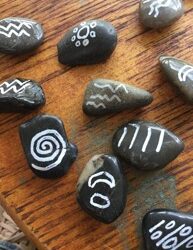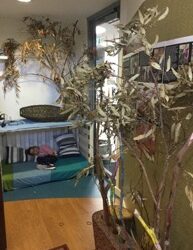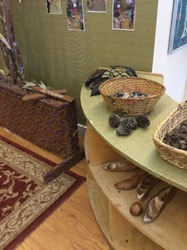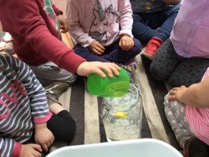Gorton House
Story by Educator Russell
Over the past few weeks, the toddlers in Gorton House have been focusing on their inner selves and how we can maintain both an inner and a visible calm. Educators have introduced yoga sessions, which are proving to be not only extremely popular but also rather successful in developing a peaceful approach to our days. We have seen an enthusiastic approach to our explorations throughout the grounds.
As part of educators’ reflective practice, we maintain a close eye on the physical environment and make changes should we feel the need exists or that the time is right, or if there is a particular interest that would be complemented by creating an area that lends itself to that 47interest or area of development for the children. As such, we are meeting the needs of the children and supporting them by creating aesthetically pleasing areas where they want to explore and extend themselves, and where they can learn through play and interaction with their peers and educators.
With this in mind, we recently looked at the area near the lockers and thought it might be a great opportunity to create a learning space that is both enriching and relaxing, a place where nature and its elements can contribute to creating a space that promotes discussion, looks at different ways of learning and that can have a focus on the Indigenous cultures of Australia. The recent Reconciliation Week provided the basis for this change. The opportunity exists to embed respect for Indigenous culture in our practices, raise awareness of the historical importance of Aboriginal people, educate the children about how the land is sacred to Aboriginal people and that we are seen as caretakers, not owners, and to celebrate and value their cultural heritage and practices, particularly surrounding art and storytelling. This can only grow and evolve by embedding this as part of our ongoing cycle of programming and evaluation, not just during Reconciliation Week.
So…. armed with enthusiasm and anticipation, we gathered, we thought, we voiced our views and we came up with the idea of creating an area that reflected nature and that celebrated Indigenous Australia—the colours, pictures and storytelling that is so integral to their culture, while still being relatable to the children.
Earlier in the year it was noted how positively the children responded to spoken stories at group time or as a settling tool, indicating that we need not be solely reliant on educators reading books to the children. We have also recently seen that the children request that educators tell them specific stories (I think Jack, Remi and Odette have worn my throat down as a result of me having to retell my variation of the Three Little Pigs many times, and Mel has been using told stories as a great settling tool when parents are leaving for the day). Perhaps this resonates with the children as they’re used to being told stories at home or at bed time, and perhaps they prefer the intimacy that told stories provide or the personal spin that individuals can place on these. Or perhaps they just like the change from sitting in a large group being read stories they’ve heard dozens of times before! Whichever way you look at it, the spoken word can provide children with a sense of warmth as well as a sense of empowerment. Becoming familiar with storytelling can stimulate their own desire to tell stories.
Our children have shown their love of spoken word stories, and they delight in sessions of interpretive dance and mimicking the actions of native Australian animals as told by the Aboriginal people, so why not give them a platform to tell their own stories by employing traditional methods?
Enter our ‘story telling rocks’. Recently we have seen educators promote a respect for recycled resources and naturally occurring resources such as rocks, branches and sticks. With this idea fresh in our minds we thought why not couple this with our desire to embed Indigenous cultural diversity in our program? Let’s take some simple pebbles/rocks, decorate them with Indigenous symbols that are used in Aboriginal artworks, and develop a resource that will allow the children to create and tell their own stories. These storytelling rocks also serve to complement our recent interest in naturally occurring loose parts construction.
We’re really enjoying using more organic materials at the moment. The different textures and surfaces are appealing to children who have a strong sensory learning capacity, and opportunities to engage children actively in problem solving tend to occur at every turn— “How can we make those round stones balance on each other?”, “Will those sticks bend enough to move them in the way you need them to?” Natural materials stimulate children’s creativity and imagination as they can be used in play in many ways.
It really is a bit of an ‘inner self’ melting pot at the moment. The combination of organic loose parts, the children’s capacity and inclination to express themselves more and more through stories, our ongoing investigations into traditional Indigenous ways of communication, our yoga sessions and the opportunity to have a nature-based chill out zone are helping to raise the children’s awareness that their inner self needs to be valued as much as their physical self. It’s been a great start amidst a crazy year, and we’re looking forward to watching the area change, evolve and grow over the rest of the year.
Murray House
Infants
Story by Educator Jung
This week groups of children from Murray House infants have spent time visiting and participating in the toddlers’ program. The purpose of these visits was to support a smooth transition from the infants’ to the toddlers’ room, as some of the children are ready to start a new learning journey in this space.
The children all seemed to love the visits, and some of them have started to name the toddlers room as the “Big room” or the “Big playground” and have been asking to have more visits. The bridge in toddlers’ playground in the sandpit has been the of the children’s favourite areas. The children practised their motor skills and enjoyed pretend play as they imagined that they were all in the jungle! It was also lovely to see the toddlers welcoming the new children with cuddles and asking questions about the them, helping the new children to feel a sense of belonging.
These visits are important as they can help the children to feel comfortable and to become more familiar with the new learning environment, enabling them to experience a successful transition in the future.
Toddlers
Story by Educator Thi My
Intentional teaching
Capitalising on Murray House toddlers’ current interest in listening to story books, especially books from the educators’ ‘special book bags’, this week Educator Thi My intentionally extended children’s problem-solving skills, thinking skills and reasoning skills through the story book Alexander’s Outing, by Pamela Allen. This book was chosen to encourage the children to engage in STEM (science, technology, engineering and mathematics) learning experiences. The story is about a duckling named Alexander, who becomes separated from his family in a park and falls down a deep dark hole. A range of methods are used to attempt to rescue poor Alexander before an impetuous small boy pours his drink down the hole, and a perfect method to save the young duckling is found.
Throughout the reading of the book the development of problem solving and reasoning skills were fostered for the children with questions such as “I wonder how they’re going to save Alexander?” “Do you think it will work?” and “What’s your idea to save Alexander?” It was great to see the children demonstrate their developing problem-solving skills with ideas like “Everyone can join hands”, “Use a rope”, “Put water in” and “Use a hose to fill up the hole!”
After the story the children were encouraged to employ their symbolic representation skills to use a tall jar to represent a deep hole and a yellow Lego brick to represent the duckling. The ‘duckling’ was put in the bottom of the jar. The children were encouraged to predict what would happen when water was poured into the jar— ‘Will Alexander [the yellow Lego brick] float or sink?” A few children predicted that it would sink while others thought it would float. The children were then encouraged to take turns to pour water into the jar. As the water rose, collectively they called out “It’s floating!” They were very excited to watch as the water rose and rose and ‘Alexander’ floated to the top and was saved!
This experience offered many learning opportunities for the children, such as developing a love of books, and developing language, concentration, thinking, eye-hand coordination, and turn taking skills.
The Potato People project
Over the last few weeks the children have been using their imaginations, creativity and fine motor skills to create ‘Potato People’, based on the book The Potato People by Pamela Allen, with Educator Deepa’s facilitation. The children have been very proud of their creations and observing how they have changed over time. Now that their Potato People have sprouted (one of the children said “My potato has horns!”), Deepa has supported them to plant their potato in the garden. Before planting the children were encouraged to observe their potatoes, share their observations with their peers, and to compare their potatoes with the pictures in the book. The children were supported to wait and take turns to dig holes and plant the potatoes in the garden.
Gardening helps children to connect with nature, stimulates their senses and fosters their motor skills as they scoop and dig dirt or water the plants. It also teaches children responsibility as they learn that it is their job to take care of the seeds and plants to help them grow.




